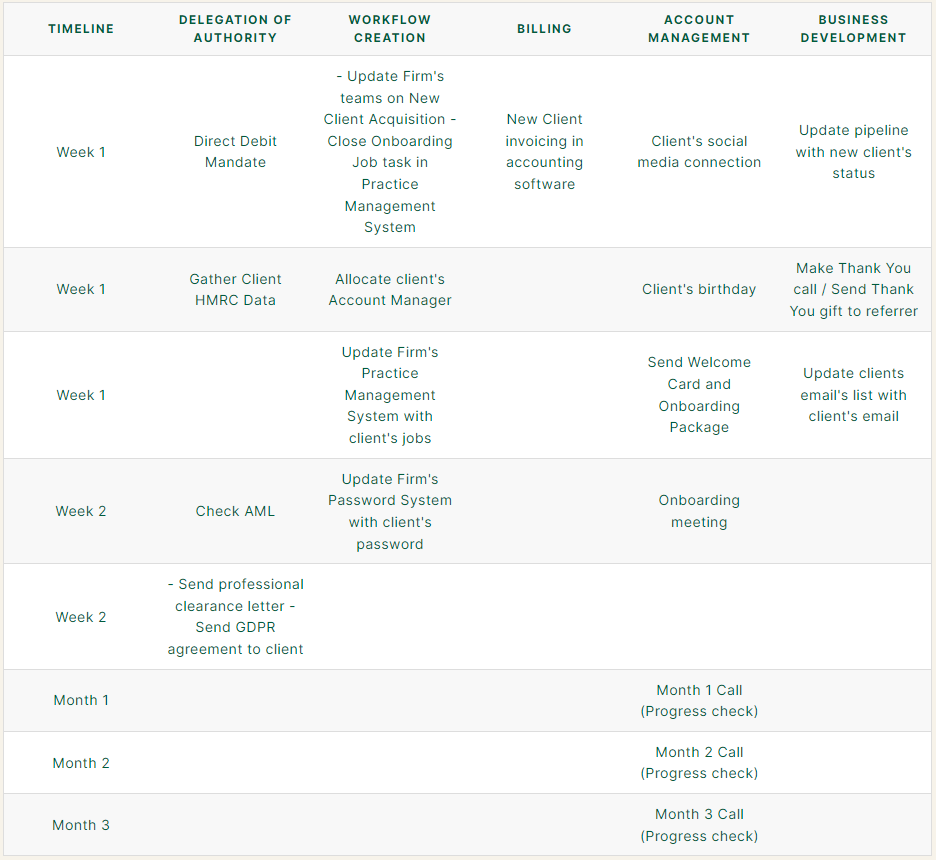
Client onboarding is the process of welcoming new clients into your business, addressing their questions and concerns, and ensuring they understand the services available to them. Who is responsible for client onboarding? How long does client onboarding take? What are the first steps in the client onboarding workflow?
THE DEFINITIVE GUIDE TO CLIENT ONBOARDING FOR ACCOUNTING FIRMS by Libeo
Client onboarding is the process of bringing new clients into your firm. It’s an important part of growing your business because it helps you to establish a strong relationship with your clients and build trust in your service.
Client onboarding begins before a contract is signed and continues after a contract has been signed. Here are some things that happen during client onboarding for accounting firms:
Client information gathering
Client interview
Project planning
Establishing financial expectations
Setting up systems and processes
Entering data into the CRM system
A well-designed client onboarding process will help your clients become more productive and successful with less effort from your team, which means more time for them to focus on what matters most: their business.
Depending on the size of your firm, the person in charge of onboarding new clients can be the Practice Manager, the Client Manager, the Business Development Person or the Administrator.
In small firms, the person who has the best relationship with the client will often be responsible for onboarding. If you're working at a medium-sized or large firm, there's a good chance that someone on your team will take over this task after you've been assigned to a new client.
Often, however, it's the responsibility of one of your more senior colleagues in the firm. For example, if you're working with a partner or senior associate on a new client, they'll probably be in charge of handing off everything to you when they leave for an appointment or meeting.
In any case, make sure that whoever takes over has all the information necessary in order to answer any questions your clients might have about their taxes and accounting needs — so it's good practice to always keep them up-to-date on what's going on with their files as well!
Onboarding can happen at different times depending on how long it takes for both parties to get ready. In some cases, it may only be a matter of hours or days before your new client is ready to go live with their first task or project; in others, it might take weeks or months before they feel comfortable enough to start using your platform regularly.

The first step in client onboarding is identifying what information you need from them. This includes things like their contact information, banking details and previous tax returns.
The next step is to create a welcome package for them which includes all of this information. Using this information, you can then transfer it into your accounting software so that you know exactly where everything is stored.
Next, you need to perform a background check on the client to make sure that they are who they say they are and don’t have any outstanding debts or criminal records against them:
Information about the client’s profile (proof of identity and address, PSC Register, Certificate of Incorporation)
Accounting software access
Online banking, credit card, and loan accounts
Account reconciliations performed most recently
Previously filed tax return copies
Organizational or incorporated documents copies
If there are any issues here, then you should speak with them directly and make sure they understand the situation before proceeding further with the onboarding process.
The third step is setting up automated tasks like email notifications and reminders. These tasks allow both parties to stay on top of deadlines and provide crucial reminders about specific events such as meeting dates or payment due dates.
Accounting firms face the challenge of ensuring new clients quickly understand how to operate effectively in their environment. Clients juggling a number of tasks and stakeholders, need assurance that their new accountants will be there for them throughout the business life cycle.
The onboarding process can vary depending on the size of your firm and whether you're dealing with an individual or business client, but there are some things that clients want to see in any onboarding process:
An introduction to key staff members
An explanation of how they will be billed (including invoices)
Training on how to use accounting software or online portals
But mostly, clients want to feel confident in their choice of accountant. In other words, they want to know that you have experience and knowledge of the industry. They also want to know that you understand their business model and goals and that you have the right skill set to accomplish those goals.
What's more, clients are looking for someone who will be a good fit culturally as well as professionally — someone who will work well with them and provide value while maintaining an efficient workflow.
A client onboarding package is a collection of documents, forms, and other items that help new clients get set up with your firm and understand their responsibilities as clients. There are many different components that can be included in a client onboarding package. Here are just a few examples:
Welcome letter from the partner or senior manager of your firm (congratulating them on joining your firm and introducing themselves)
Your business card so they have easy access to contact information if they need it right away (like if they have an urgent question).
Letter from the CPA who will be working with them (introducing themselves and asking if there's anything they can do to help)
Client agreement form (explaining how they should expect to work with you over time and outlining the billing process)
A folder with all of the documents they need to fill out during the first meeting (e.g., tax forms). This makes it easier for both parties to stay organized during paperwork-intensive processes like tax season or year-end reviews.
You’ve landed your first client. Now what?
While this is a major milestone, it’s just the beginning of a long and fruitful relationship with your new client. The first few weeks are about getting to know each other and setting the foundation for future success. It’s also a time when you can set the tone for future engagements, so it pays to do things right from the start.
There are four key components of client onboarding: compliance, clarification, culture and connection. Let’s look at each in turn.
The CPA industry is obsessed with compliance, which means that even small firms have to put in enormous time and effort to ensure that they're doing everything right. Compliance is an important part of client onboarding because every firm has a different set of compliance requirements depending on their industry and state regulations. You may already have an established protocol in place, but if not, start by creating a checklist that outlines each action item required by your firm.
For example, if you specialize in estate planning, you will likely require your clients to complete the necessary forms prior to starting work with them.
New clients will need to sign an NDA (non-disclosure agreement), review policies and procedures and sign contracts. These documents should be presented at the outset of the onboarding process so that they can begin working with you in an informed manner, without having to ask questions later on down the road.
Once you've gained compliance, it's time to clarify key elements of working together such as how often they'll be billed and when payments are due, what services they can expect from you and what they should expect from themselves (e.g., keeping up with transactions or performing periodic reviews). This is the best way to avoid scope creep in the future and ensure that everyone is on the same page.
The next step is helping clients get comfortable with your culture — whether that means providing them with an overview of our company or understanding how each party works best and how they prefer to communicate with each other (i.e., email vs phone vs text). As well as learning about each others' cultures so there aren't any surprises down the road if one party doesn't want
Your clients want to feel connected to their accountant. They want someone who listens to their concerns, who cares about their financial well-being and who will protect their best interests as if they were their own family members.
Don’t be afraid to ask questions or take time for small talk during your initial meetings — these are opportunities for building connections that will go a long way toward creating long-lasting relationships in the future.
A survey of accounting firms conducted by the American Institute of CPAs (AICPA) found that client onboarding is one of the top challenges for firms. In fact, just one third of the firms surveyed said they were satisfied with how they handled client onboarding.
Accounting firms are embracing new technologies that can improve the client onboarding process, and make it easier to deliver more value to clients.
If you’re not sure why you should be automating your client onboarding process, here are three reasons to consider:
Increased efficiency and productivity
Improved client satisfaction
Improved employee retention
The benefits of automating the client onboarding process are clear:
The automation of paperwork and compliance tasks reduces the time it takes to complete the process, and increase the chance that all relevant information is captured at the start.
Automation also allows you to capture data more accurately and consistently, which provides you with a better understanding of your clients' business, their needs and how they are performing. This in turn helps you build better relationships with them, which is essential for retaining their trust and loyalty.
Automation also helps reduce errors and omissions, which can be costly if you need to re-start a new engagement because of information not being captured or incorrect documents being sent to HMRC or Companies House.
A successful client onboarding program can help you stand out from the competition, build trust and generate referrals. Here are some ways to automate the process:
Automate the first meeting. Your first meeting with a new client should be as painless as possible. Make sure they're comfortable, introduce them to your team and get them started on the right track with automated reminders and checklists.
Set up automated reminders for recurring tasks. Set up automated reminders for recurring tasks like bill payment reminders or quarterly reviews via email or text message so you don't miss anything important.
Streamline the invoicing process. Create a simple payment portal that allows clients to pay online or submit expense reports from their smartphone or tablet so they don't have to remember another password or log in multiple times per day.
Latest news, events, and updates on all things App related, plus useful advice on App advisory - so you know you are ahead of the game.